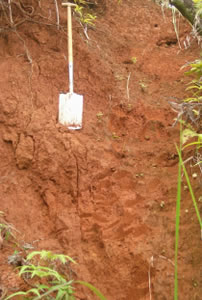Dr. Victor Asio
Department of Agronomy and Soil Science
Leyte State University, Baybay, Leyte 6521-A, Philippines
 The soil cover of the earth or pedosphere is a critical component of landscapes and terrestrial ecosystems. It serves as medium for plant growth, ecological filter and buffer, source and sink of greenhouse gases, habitat for the myriad soil microorganisms which help plants grow and detoxify environmental pollutants. In many parts of the world, soils are destroyed by agricultural, industrial, mining, and other human activities thus, threatening food supply and ecological balance. Soil degradation is thus one of the most serious ecological problems in the world today particularly in the humid tropics like the Philippines. This is generally caused by the unsuitable land use systems and improper soil management strategies due to poor understanding of the nature, characteristics, and potential of different soils. There is thus a need for pedological studies to help us better understand our soils particularly those on young tropical islands, like most Philippine islands, which have received very little research attention until now.
The soil cover of the earth or pedosphere is a critical component of landscapes and terrestrial ecosystems. It serves as medium for plant growth, ecological filter and buffer, source and sink of greenhouse gases, habitat for the myriad soil microorganisms which help plants grow and detoxify environmental pollutants. In many parts of the world, soils are destroyed by agricultural, industrial, mining, and other human activities thus, threatening food supply and ecological balance. Soil degradation is thus one of the most serious ecological problems in the world today particularly in the humid tropics like the Philippines. This is generally caused by the unsuitable land use systems and improper soil management strategies due to poor understanding of the nature, characteristics, and potential of different soils. There is thus a need for pedological studies to help us better understand our soils particularly those on young tropical islands, like most Philippine islands, which have received very little research attention until now.
Samar is the third largest and one of the most underdeveloped islands of the Philippines. Here large areas of unproductive lands remain idle due to severe fertility problems associated with the strongly weathered (or old) nature of the soils. The occurrence of these old soils is interesting to science considering the fact that Samar is a young island geologically. Particularly in Samar’s central part, a strongly weathered, deep, red soil developed from a rock called slate is widespread. Interestingly, it closely resembles another strongly weathered soil in the southeastern part of the island although the latter developed from a different rock called peridotite (ultrabasic rock). So we conducted this research to evaluate the morphological, physical, chemical, and mineralogical characteristics of the two soils in order to explain their development and gain insight into their productivity and possible response to management.
 |
 |
| Figure 1. Profile of Bagacay soil derived from slate | Figure 2. Profile of Salcedo soil derived from peridotite |
We found a suitable site for studying the first soil (Fig 1) in a place called Bagacay located in the middle of a forested landscape in the central part of the island (elevation: 400 m above sea level). We took soil samples from all soil layers (or soil horizons) down to a depth of 5.5m. For the second soil (Fig 2), we examined and sampled a soil profile in the coastal town of Salcedo located at an elevation of 50m above sea level. We took samples from all soil layers down to a depth of 5m. In addition we collected rock samples from both sites for identification and analysis. Laboratory analyses were conducted in the Pedology Laboratory at Leyte State University in Baybay, Leyte, and at the Institute of Soil Science and Plant Nutrition, Martin Luther University in Halle, Germany,
Our findings revealed that the two soils are closely related in most characteristics evaluated although the one derived from the more weatherable or easier to decompose ultrabasic rock is in a more advanced stage of weathering and soil development (the soil is called a Haplic Ferralsol) than that derived from slate (the soil is called Haplic Acrisol). There were however some notable differences between the two soils such as in terms of contents of quartz, Fe oxides, gibbsite, Ni and Cr which are all related to the geochemical composition of the parent rock material. The high levels of the heavy metals Ni and Cr in the Salcedo soil may pose a health risk to the people living in the area. Both soils have very low fertility status and need special soil management strategies to improve their productivity due to their chemical and mineralogical characteristics. Finally, the study has shown that the contribution of salt spray to soil development appears important in coastal areas of tropical islands. And on the geologically young humid tropical island of Samar, the geochemical characteristics of the parent rock material and the stability of the geomorphic surface are major factors determining the formation and characteristics of the strongly weathered soils.
This research was the product of international collaboration involving Ian A. Navarrete and Dr. V.B. Asio from Leyte State University in the Philippines, Dr. R. Jahn from Martin Luther University, Germany, and Dr. K. Tsutsuki from Obihiro University of Agriculture and Veterinary Medicine, Japan.
Reference:
Ian A. Navarrete, Victor B. Asio, Reinhold Jahn, and Kiyoshi Tsutsuki, “Characteristics and genesis of two strongly weathered soils in Samar, Philippines,” Australian Journal of Soil Research 45 (2007) 153-163.
___________
Dr. Victor B. Asio is a professor of Soil Science and Geo-ecology and the current head of the Department of Agronomy and Soil Science of Leyte State University, Baybay, Leyte. He obtained his Bachelor of Science in Agriculture Soil Science from the Visayas State College of Agriculture (Now, Leyte State University), his Master of Science in Soil Science from University of the Philippines in Los Banos, Laguna, and his PhD in Soil Science and Site Ecology from the University of Hohenheim, Germany.